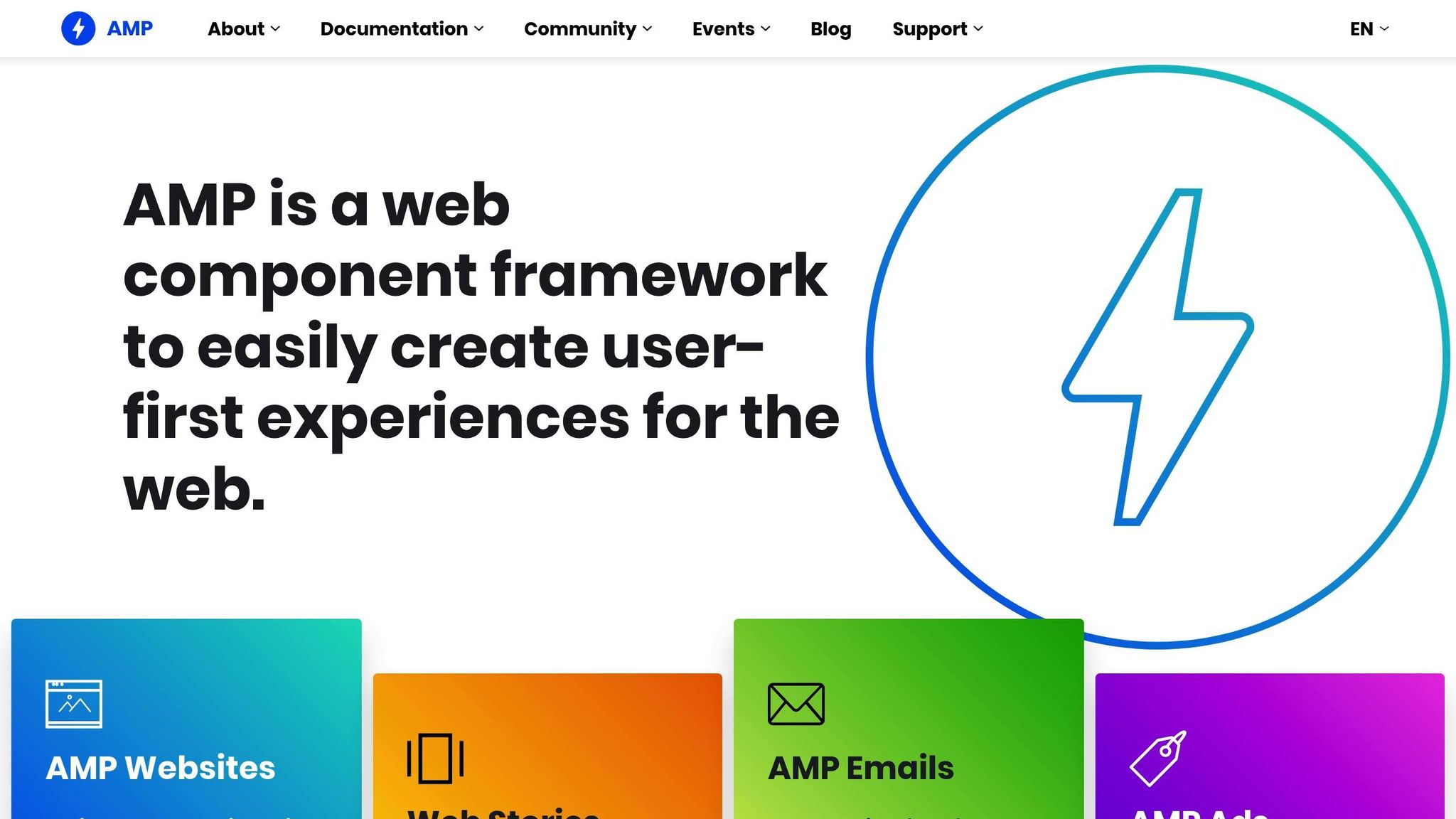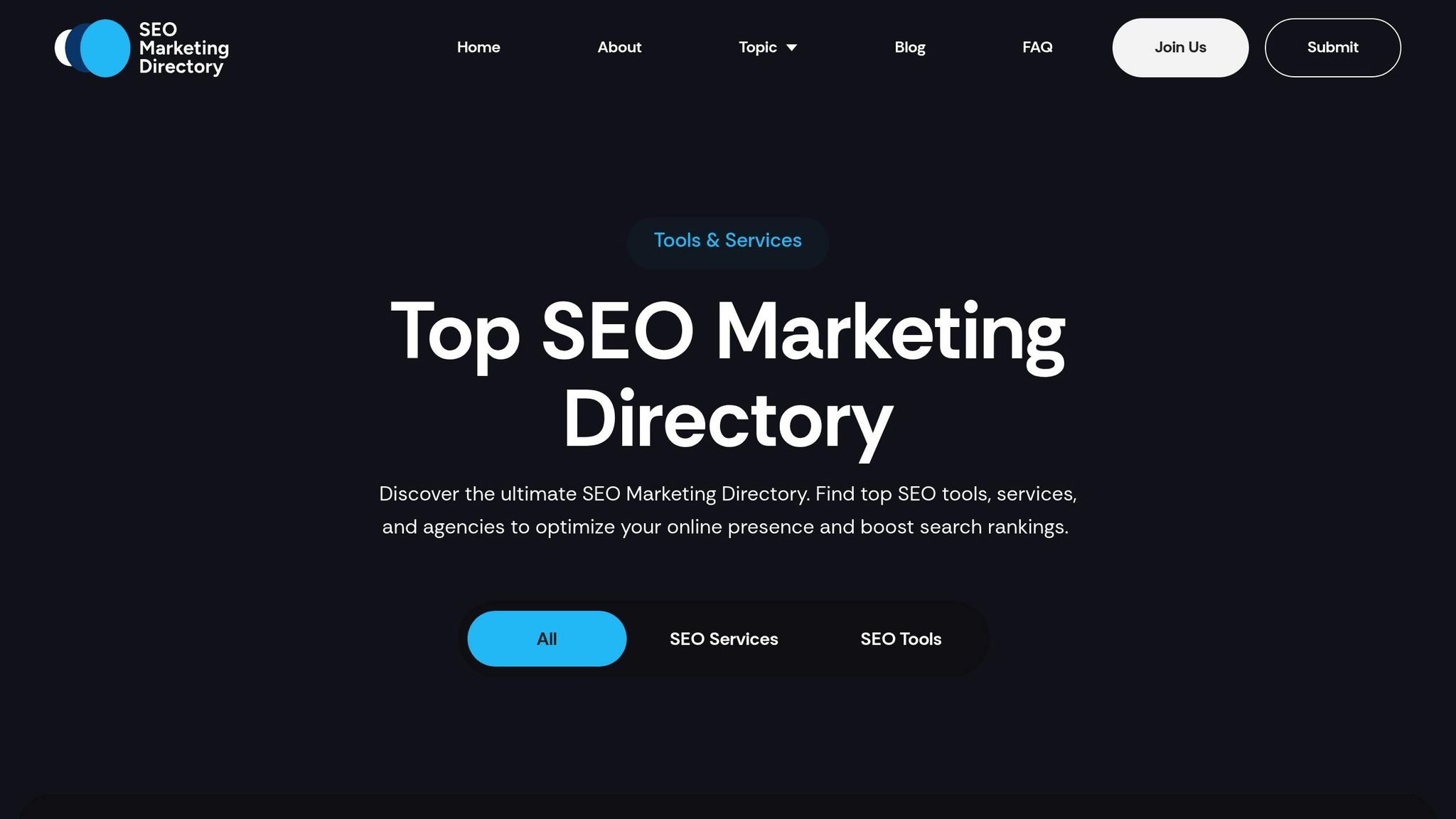Still wondering if AMP is right for your website in 2025? Here's the quick answer: AMP (Accelerated Mobile Pages) can improve mobile page load times, but it's not for everyone. It simplifies content delivery, which helps with speed but limits design and functionality. The decision depends on your site's goals, audience, and technical requirements.
Key Takeaways:
- AMP is ideal for content-heavy sites (e.g., blogs, news) where speed matters more than design flexibility.
- E-commerce and interactive sites may struggle with AMP's restrictions on custom JavaScript and advanced features.
- Alternatives like optimizing for Core Web Vitals or using Progressive Web Apps (PWAs) might offer better results for many websites.
How to Decide:
- Analyze Your Audience: Use Google Analytics to check mobile traffic, bounce rates, and session duration. If your site is slow and relies on mobile search, AMP could help.
- Assess Site Goals: AMP works best for static content. If you need custom features or branding flexibility, it might not be the right choice.
- Test AMP on Sample Pages: Compare AMP vs. non-AMP performance for metrics like load times, bounce rates, and conversions.
- Compare Alternatives: Evaluate AMP against other options like PWAs or Core Web Vitals optimization.
Bottom Line: AMP isn't as dominant as it once was, and many top-ranked sites now avoid it, opting instead to focus on Core Web Vitals. Carefully weigh the pros and cons before deciding.
What is AMP and Why It Matters in 2025

AMP, short for Accelerated Mobile Pages, is a framework designed to make mobile web pages load faster by simplifying their structure. It works by creating lightweight versions of web pages that focus on speed, often at the expense of more complex design elements. In 2025, the conversation around AMP is about finding the right balance between its speed advantages and the limitations it imposes on functionality and design.
The primary goal of AMP is to ensure quick access to content, especially for users on slower networks or older devices. This aligns well with the ongoing emphasis on mobile-first indexing, where search engines prioritize mobile-friendly content. By offering near-instant load times, AMP can help businesses cater to these users effectively.
That said, the mobile web has come a long way since AMP was first introduced. Advances in web technologies and better mobile internet speeds have reshaped how companies approach mobile optimization. As a result, businesses now need to carefully evaluate whether AMP fits into their current SEO strategies and meets the expectations of modern users.
Grasping the basics of AMP and its role in today’s mobile web environment is key to deciding whether it’s the right solution. From here, it’s important to dive deeper into its benefits and potential drawbacks to make an informed choice.
AMP Pros and Cons
AMP offers faster load times and can improve user engagement - both crucial factors for mobile SEO success. Its ability to streamline content delivery ensures a smoother experience for mobile users. However, it comes with trade-offs. AMP's framework restricts custom JavaScript, which could limit interactive elements and advanced tracking features that some websites rely on.
Before deciding, consider how these limitations might impact your site's functionality. Evaluate your audience's needs and analyze your site's metrics to determine if AMP's benefits outweigh its restrictions for your specific strategy.
How to Determine if AMP is Right for Your Site
Deciding whether to adopt AMP for your website involves more than just aiming for faster loading times. It’s about weighing its advantages and limitations against your business goals and understanding how it fits into your audience's expectations. Here's how to evaluate if AMP is a good match for your site.
Analyze Your Audience and Device Usage
Start by diving into Google Analytics to study your mobile traffic patterns, session duration, and bounce rates. Mobile performance is critical - research shows that 47% of users expect a page to load in 2 seconds or less. If your mobile pages are consistently slower, AMP might solve a significant issue for your audience by improving load times.
Also, consider where your traffic comes from. Websites that rely heavily on Google's mobile search results often see stronger benefits from AMP. Platforms like news sites, blogs, and content-heavy websites typically gain the most, as AMP content is often prioritized in Google’s news carousels and search results.
Review Website Goals and Required Features
Your website's purpose and functionality play a big role in determining AMP’s suitability. E-commerce sites, for instance, may face challenges. If your site uses complex product configurators, relies on custom JavaScript, or has an intricate checkout process, AMP's restrictions could limit essential features.
Branding is another factor to consider. AMP’s standardized structure can restrict design flexibility, which might impact your site’s visual identity. If maintaining full control over your user experience and design is non-negotiable, this trade-off could outweigh the benefits of faster speeds.
However, for content-driven sites like blogs or publishing platforms, AMP often works well. Its streamlined format aligns with the goal of delivering content quickly and efficiently without compromising essential functionality.
Check Performance Data and Metrics
Once you’ve assessed AMP’s technical compatibility with your site, it’s time to review performance data. Use Google Search Console to analyze your current mobile performance metrics, such as clicks, impressions, and keyword rankings. This data will highlight areas where AMP could make a tangible difference.
The potential benefits of AMP are supported by real-world examples. For instance, GEORGE at ASDA reported a 13% higher click-through rate (CTR) from mobile search after adopting AMP, with their top 500 queries moving up by an average of one position. Similarly, KapanLagi.com saw a 50% reduction in bounce rate after implementing AMP Linker.
E-commerce sites have also seen impressive results. A WompMobile case study showed that AMP pages led to a 105% increase in conversion rates and a 31% drop in bounce rates across various clients.
Beyond these examples, keep an eye on Core Web Vitals - AMP’s speed and stability improvements can enhance metrics like page load time, interactivity, and visual stability, indirectly boosting your search visibility. While AMP isn’t a direct ranking factor, its impact on user experience metrics can influence your site’s search performance.
To make an informed decision, track key performance indicators such as page load times (aim for under 1 second), traffic comparisons between AMP and non-AMP pages, bounce rates, conversion rates, and engagement metrics like scroll depth and time on page. These insights will guide your next steps and set realistic expectations for what AMP can achieve.
sbb-itb-5be333f
Step-by-Step AMP Evaluation Process
To determine if AMP is the right fit for your website, start by establishing a performance baseline. This will allow you to measure AMP's impact accurately. With your audience insights and site goals in mind, follow this systematic evaluation process to gather actionable data.
Test Your Current Mobile Performance
Before diving into AMP, it's essential to assess how your site currently performs on mobile devices. A great place to start is Google PageSpeed Insights (PSI). Simply enter your website's URL, and you'll receive a detailed performance report. This report includes real-user data from the Chrome User Experience Report (CrUX) and lab-simulated data from Lighthouse.
Focus on key metrics like:
- FCP (First Contentful Paint)
- INP (Interaction to Next Paint)
- LCP (Largest Contentful Paint)
- CLS (Cumulative Layout Shift)
- TTFB (Time to First Byte)
Pay close attention to the 75th percentile values, as these often reflect the most challenging user experiences on your site. Additionally, PSI provides a Core Web Vitals assessment, which offers an overview of your page's overall experience quality. Don't skip the lab diagnostics section - it simulates load performance on a typical mobile device, giving you insights into potential user experiences.
For ongoing monitoring, Google Search Console is an invaluable tool. Its Core Web Vitals reports and Search Analytics can help you track performance trends and identify which search queries are driving traffic to your site.
Run an AMP Test Implementation
Once you've established a baseline, it's time to test AMP on a sample of your site. Select 10–20 pages that represent your typical content and traffic patterns. These might include popular blog posts or key landing pages.
Over the course of 4–6 weeks, monitor critical metrics such as:
- Page load times
- Bounce rates
- Engagement indicators (e.g., scroll depth, time on page)
- Conversion rates and revenue per visitor (for e-commerce sites)
Use Google Analytics to isolate AMP traffic from non-AMP traffic. This can be done with UTM parameters or custom dimensions, allowing you to directly compare performance. Keep an eye out for technical challenges, such as issues with JavaScript, forms, or third-party integrations, and document any workarounds you implement. Once you've gathered this test data, you can compare AMP's results with other optimization methods.
Compare AMP Results with Other Options
Now it's time to weigh your AMP test results against other mobile optimization strategies, keeping your site's unique needs in mind. AMP is just one way to improve mobile performance, and it’s important to evaluate how it stacks up against alternatives.
A decision matrix can help you compare options based on factors like:
- Implementation cost
- Development time
- Performance improvements
- Feature flexibility
- Maintenance effort
- Long-term scalability
For example, while AMP might provide quick performance boosts, other solutions like Progressive Web Apps (PWAs) might deliver richer functionality and design flexibility, albeit with a more complex setup.
Don’t forget to consider your technical team’s expertise and your desired user experience. AMP is great for fast, consistent loading, but it comes with design limitations. On the other hand, PWAs can create app-like interactions, though they may require additional resources.
Finally, think about your content distribution strategy. If your site relies on visibility in features like Google’s Top Stories or news carousels, AMP might offer distinct advantages in this area. Compare these benefits with what other strategies can deliver to make an informed decision.
Using Resources for AMP Evaluation
Once you've run your performance tests, the next step is to make informed decisions using expert resources. Pair your AMP performance results with insights from curated directories to streamline your evaluation process.
Top SEO Marketing Directory Overview

The Top SEO Marketing Directory is a go-to resource for finding tools, agencies, and solutions tailored to AMP evaluation and mobile SEO. This directory connects you with experienced SEO professionals who specialize in areas like technical SEO audits, mobile performance testing, and AMP-compatible content management systems. These experts have a proven track record of success in implementing AMP strategies.
Instead of wading through endless search results or relying on unverified sources, this directory offers access to vetted agencies and tools that have delivered measurable results in mobile SEO. It includes development teams skilled in the technical aspects of AMP deployment and analytics platforms designed to monitor AMP-specific metrics.
For businesses in the U.S., the directory highlights providers that offer local support, work with U.S. dollar pricing, and understand American business norms. This localized approach ensures smoother communication and project management, making the AMP evaluation process more efficient.
Additionally, the directory features an educational section with valuable insights on topics like server response time, Core Web Vitals, and mobile testing automation - key elements for understanding how AMP can improve your mobile performance.
Simplifying Your Evaluation Process
Using curated directories can save you time and improve results. They help reduce vendor research time by up to 30% while increasing satisfaction with your chosen partners. Instead of spending weeks searching for the right tools or agencies, these directories offer expert recommendations and comparisons.
You can quickly evaluate options by reviewing client testimonials, case studies, and user reviews. Whether you're an e-commerce brand aiming to speed up mobile load times or a content publisher focused on optimizing mobile user experience, the directory helps you identify providers with relevant expertise and proven outcomes.
When choosing AMP-related tools or agencies, prioritize providers with experience in AMP projects, integration capabilities with your existing platforms, and a track record of delivering measurable improvements in metrics like page speed, bounce rate, and mobile search rankings.
To make the most of the directory, follow these practical steps: define your mobile SEO goals, search for AMP-focused providers, review their profiles and case studies, contact shortlisted vendors for proposals, and use the directory's guides to ensure a thorough evaluation. This structured process minimizes common challenges like assessing vendor credibility, technical knowledge gaps, and uncertainty about AMP's impact on SEO. By integrating these curated tools and resources, you can confidently advance your AMP evaluation efforts.
Conclusion: Making the Right AMP Decision
When considering AMP in 2025, it’s essential to align its benefits with the unique needs of your site. The numbers paint an interesting picture: only 6% of top-ranked Google pages are AMP versions, and AMP adoption has plummeted by over 50% since 2022. These shifts highlight the importance of balancing AMP’s speed advantages against its limitations.
Your decision should hinge on factors like audience behavior, site objectives, and technical capabilities. If your audience primarily uses slow mobile networks and your content is static - think news articles or blog posts - AMP could still provide value. On the other hand, for e-commerce platforms, SaaS businesses, or sites requiring advanced tracking and personalization, AMP’s restrictions may outweigh its benefits.
Instead, focusing on Core Web Vitals has become a critical priority. With 75% of publishers now optimizing non-AMP pages for Core Web Vitals, enhancing metrics like Largest Contentful Paint, Interaction to Next Paint, and Cumulative Layout Shift can often yield better results than adopting AMP’s rigid framework. Notably, 79.2% of Top Stories content in the U.S. is now served through non-AMP pages, proving that fast, well-optimized pages can compete effectively without AMP.
Maintaining dual versions and adhering to AMP’s resource constraints can present ongoing technical hurdles. Fortunately, modern web development practices now offer alternative methods to achieve quick load times without these limitations. This is where expert advice becomes invaluable.
By consulting the Top SEO Marketing Directory, you can access a network of vetted SEO professionals and technical specialists. These experts can guide you through the trade-offs between speed and functionality, helping you craft a mobile SEO strategy that fits your goals for 2025.
Ultimately, your approach - whether it’s AMP, Core Web Vitals optimization, or a combination of both - should align with your site’s needs, ensuring a seamless mobile experience that supports your business objectives.
FAQs
What should I consider when deciding between AMP, PWAs, and Core Web Vitals for mobile optimization in 2025?
When planning your mobile optimization strategy for 2025, it's essential to weigh how AMP, PWAs, and Core Web Vitals fit with your website's objectives and the experience you want to deliver to users.
Google has shifted its focus to Core Web Vitals - key metrics like page load speed, responsiveness, and visual stability - making them more critical for mobile rankings than AMP. On the other hand, PWAs (Progressive Web Apps) provide a more app-like experience, boost user engagement, and help reduce bounce rates, positioning them as a strong option for enhancing mobile performance.
The right choice depends on what aligns best with your site's performance goals, user needs, and SEO strategy. While AMP might still serve specific purposes, PWAs and Core Web Vitals offer more comprehensive advantages for today's mobile optimization challenges.
How can I evaluate the performance of AMP pages compared to regular mobile pages on my website?
To evaluate how AMP pages stack up against regular mobile pages, focus on a few critical metrics: core web vitals, page load times, and user engagement levels. Tools like Google PageSpeed Insights and Lighthouse can help you dive into these metrics, offering insights into speed and usability differences between the two formats.
For a more detailed analysis, consider running A/B tests through analytics platforms. Track real-world user data, including bounce rates, session lengths, and conversion rates, to see which version aligns better with your objectives. This approach provides a clearer understanding of how AMP influences user experience and SEO, helping you shape a smarter mobile strategy for 2025.
What challenges do e-commerce sites face with AMP, and how can they address them?
AMP can create obstacles for e-commerce sites, particularly with customization and interactivity. Since AMP limits the use of custom JavaScript and certain HTML elements, it can be tricky to implement advanced features, such as personalized shopping experiences. On top of that, AMP's restrictions can affect ad placement options and reduce the effectiveness of interactive elements, which might hurt both revenue and conversion rates.
To navigate these challenges, businesses can take a few steps. They can invest in training their teams to implement AMP effectively, disable AMP selectively on pages that need more advanced functionality, and fine-tune their AMP pages to balance speed with user experience. This way, they can still enjoy AMP's faster load times without sacrificing essential features.


